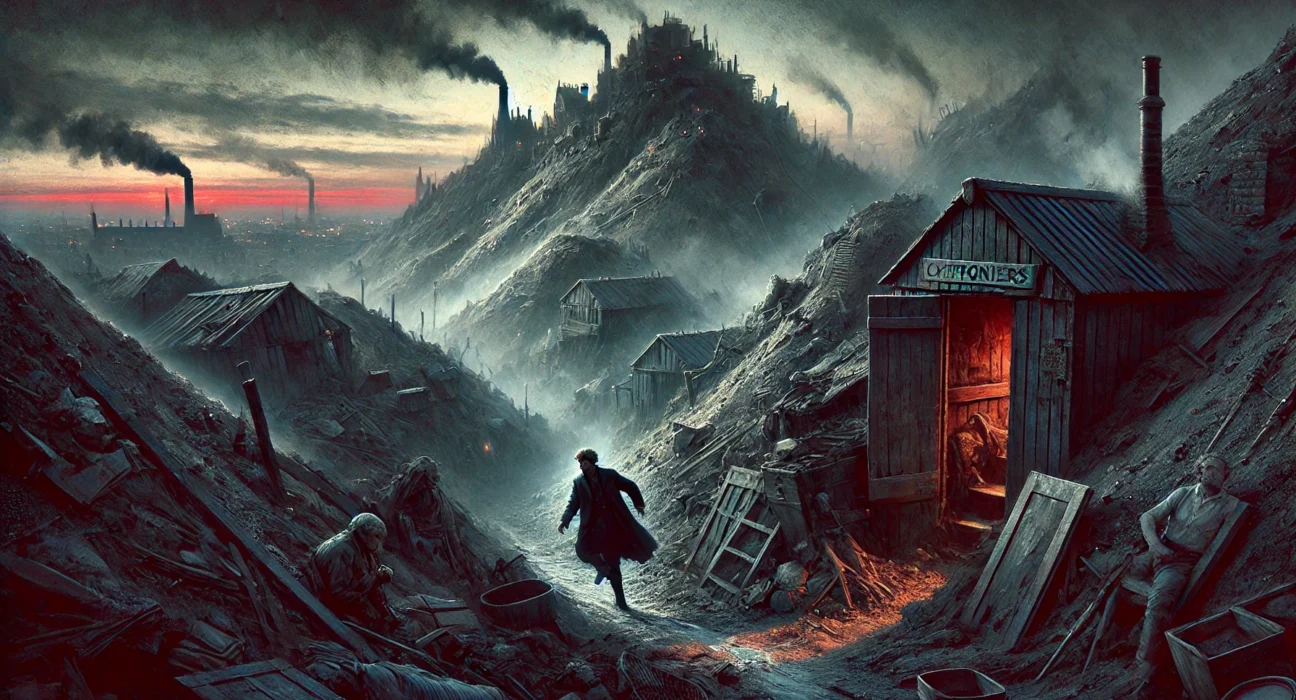Bram Stoker’s The Burial of the Rats, published in 1914, is a suspenseful horror story set in Paris in the mid-19th century. Known primarily for Dracula, Stoker explores another terrifying adventure here, one that blends the dangers of urban underworlds and supernatural overtones. The story revolves around a young Englishman, whose journey into Paris’s darker quarters transforms a casual exploration into a nightmarish chase for survival among predatory rag-pickers.
Plot Summary
Leaving behind the bustling city, an Englishman, young and solitary, roams the outskirts of Paris. He is lingering in France for a year, separated from the woman he loves by a promise to her parents, which forbids him from contacting her. Finding Paris’ regular sights unfulfilling, he explores its fringes, eventually reaching Montrouge, an area notorious for its dust heaps and rag-pickers. His fascination with this hidden world grows, and he becomes intent on witnessing the reality of Paris’ underbelly, the strange land where filth and poverty breed their own society.
One day, he delves further into Montrouge, captivated by the mounds of discarded objects and refuse that tower like grotesque monuments. As he ventures deeper, the heaps form a maze around him, cutting off his retreat. This is no ordinary refuse yard but the domain of the chiffoniers—rag-pickers, living amid decay, scavenging daily from the debris of Paris. His path takes him among huts cobbled together from fragments of broken furniture and scrap, home to figures both pitiful and malevolent. He catches glimpses of men who once fought for the Republic, now left hollow and dangerous. They are watching him with grim interest, and in the growing shadows, their gaze feels ominous.
Continuing his exploration, he encounters an old woman with a face hardened by time. She invites him to rest, seating him in her shack and introducing him to Pierre, an elderly man as frail in appearance as the woman, but with an underlying ferocity. She speaks with great energy, recalling her life in revolutionary Paris, a time of horror and grim revelry. The old woman entertains her guest with stories of the past, and the narrator becomes entranced by her accounts of bloodshed and guillotines. However, something uneasy settles in the air. He senses a subtle change in her expression, an ominous glint in her eyes. He tries to shake the feeling, attributing it to his unfamiliar surroundings, but the feeling only grows.
As dusk settles and the air turns chilly, he rises to leave. But the old woman’s glance flickers to his hands, where a signet ring glints in the dim light. She asks to see it, her fingers lingering over the precious stone with a possessive admiration. Pierre, too, casts a glance toward the ring, and the Englishman realizes he has been surrounded by silent, calculating stares. The hut grows darker, and he notices that several other figures are positioned outside, blocking any easy escape. The unease that had lingered is now unmistakable, and fear gnaws at him. They are plotting something more sinister than mere curiosity.
He struggles to keep his expression calm, speaking casually about the life of rag-pickers, feigning curiosity in their grim existence. The old woman indulges him with elaborate tales, her voice taking on an eerie quality. She recalls the sewer rats in Paris, their sheer number, and the silent efficiency with which they clean bones. He senses that her words contain a hidden threat, a warning of the peril awaiting him should he attempt to resist. As she talks, he watches her slyly take a dagger from her tattered dress, eyes gleaming with anticipation.
At that moment, his fear turns to icy determination. He makes a sudden leap, hurling himself against the hut’s wall and breaking through the rotting boards. Tearing his way free, he lands outside, stumbling over the figures of rag-pickers waiting just beyond the wall. The entire heap of boards collapses as the figures outside shout and spring after him, and the whole camp seems to come to life, scrambling to close in around him. He bolts, scrambling up a steep pile of dust and filth that crumbles beneath his weight. He chokes on the rancid smell, but the urgent pulse of survival pushes him onward, away from the hands reaching through the darkness to pull him down.
At the top of the mound, he sees the lights of Paris flickering faintly in the distance, the beacon of an escape route. With the rag-pickers in deadly silence trailing behind him, he races across the ridge of dust heaps. The terrain beneath him slopes treacherously, and at any moment, he feels he might lose his footing and tumble back into their waiting arms. The rag-pickers are relentless, following him as silently as shadows, their pace slow but deliberate, blocking any hope of easy escape.
Reaching a flatter area, he dashes across a stretch of mud and stagnant pools that seem to stretch endlessly. Ahead, he spots Fort Montrouge, dark and distant, but a symbol of hope. He knows the way to Paris lies beyond it and moves with renewed vigor. But the marshland beneath him clings to his steps, slowing him down, while his pursuers navigate the ground with practiced ease, herding him toward a stretch of open land where they can easily intercept him.
Realizing his predicament, he changes course, seeking refuge in a ditch filled with filthy, reeking water. As he emerges on the other side, he hears his pursuers drawing closer, their pace quickening as they sense his weakening steps. But he presses forward, driven by a memory of his beloved in England, the thought of returning to her fueling his every labored breath. He scrambles up yet another mound, and on the other side, a low wall offers momentary shelter. Collapsing behind it, he gathers himself as he watches the rag-pickers pass by, missing his hiding place.
Summoning his remaining strength, he crawls forward, desperate to escape the dust-heap maze. The figures close in again, dark shapes silhouetted against the city lights, which now glow closer. At last, he sees the edge of the refuse pits and beyond it, the Parisian night stretching wide and safe. With a final burst of strength, he breaks free from the dust heaps and runs toward the glow of lanterns on the main road, where soldiers patrol the city’s edge. He shouts out, alerting them to his presence, and collapses just as they reach him. The soldiers take him in, their questions drowned out by his relief as he realizes he has escaped the city of dust.
Later, he would learn that the rag-pickers had disappeared into the night, their dark deeds hidden once more among the dust heaps. His year of waiting would eventually end, and he would return to England and his beloved. Yet he would never forget that night in Paris, where he had wandered too far and too close to the ravenous heart of the city’s secrets, escaping only by a thread from the burial ground of rats.
Main Characters
The Narrator: A young Englishman in love with a woman back home, currently bound to a probationary period away from her. His exploration and curiosity about Paris lead him into dangerous situations, making him a figure of both innocence and bravery as he grapples with survival.
The Old Woman: A cunning and malevolent rag-picker, whose friendliness hides a sinister nature. She embodies the desperate, brutal survival tactics of her impoverished world, luring the narrator into her plot with feigned kindness.
Pierre: An older man, accomplice to the old woman, and an embodiment of Stoker’s image of gritty, relentless evil. Pierre is part of the story’s terror, maintaining a menacing presence as he collaborates in the old woman’s plan to entrap the narrator.
Theme
Urban Decay and Horror: Stoker paints Paris not as a romantic city but as a place of grime and shadows, where the impoverished lurk with predatory intent. The dust heaps, where discarded objects and people coexist, symbolize the dehumanizing effects of poverty and urban neglect.
Predatory Instinct and Survival: The rag-pickers are depicted as nearly feral, driven by a need to scavenge and survive. Stoker uses them to question the lines between human and animalistic behavior, highlighting how desperation can drive people to terrifying extremes.
Isolation and Fear: The narrator’s isolation in a foreign city amplifies his vulnerability. This theme is intensified by Stoker’s use of suspense and psychological horror, showing how isolation can turn even simple surroundings into terrifying landscapes.
Death and Decay: Rats symbolize death throughout the story, circling around the living as if waiting for them to falter. They are both literal and figurative agents of decay, tying into the story’s grim setting and the ever-present sense of looming death.
Writing Style and Tone
Stoker’s writing is richly atmospheric, leaning heavily on descriptive language to create a vivid sense of place that is simultaneously foreign and menacing. He draws the reader into an immersive experience, starting with a detailed look at Paris’s underbelly before building tension through subtle signs of danger. His pacing shifts from methodical exploration to a breakneck chase as the narrator’s situation grows more desperate. The tone of the story is darkly foreboding, underscored by Gothic horror elements, and Stoker carefully crafts scenes that resonate with the claustrophobic, nightmarish atmosphere essential to the genre.
The style also benefits from Stoker’s talent for psychological horror, with moments of introspective dread that lend depth to the narrator’s experience. Stoker’s use of internal monologue helps readers feel the narrator’s creeping fear and growing paranoia. With a blend of suspense, dread, and carefully placed action, The Burial of the Rats is a powerful example of Stoker’s ability to turn an environment into a lurking antagonist, transforming Paris into a character of its own with its dust heaps, hidden passages, and relentless, inhuman inhabitants.
We hope this summary has sparked your interest and would appreciate you following Celsius 233 on social media:
There’s a treasure trove of other fascinating book summaries waiting for you. Check out our collection of stories that inspire, thrill, and provoke thought, just like this one by checking out the Book Shelf or the Library
Remember, while our summaries capture the essence, they can never replace the full experience of reading the book. If this summary intrigued you, consider diving into the complete story – buy the book and immerse yourself in the author’s original work.
If you want to request a book summary, click here.
When Saurabh is not working/watching football/reading books/traveling, you can reach him via Twitter/X, LinkedIn, or Threads
Restart reading!








